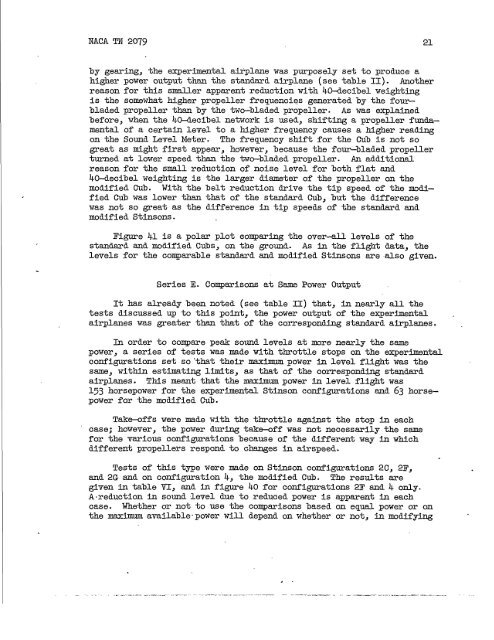Experiments in External Noise Reduction of ... - CAFE Foundation
Experiments in External Noise Reduction of ... - CAFE Foundation
Experiments in External Noise Reduction of ... - CAFE Foundation
Create successful ePaper yourself
Turn your PDF publications into a flip-book with our unique Google optimized e-Paper software.
NACA TN 2079 21,by gear<strong>in</strong>g, the experimental ailq?lanewas purposely set to produce ahigher power output than the standard atiplane (see table II). Anotherreason for this smaller apparent reduction with 40-decibel weight<strong>in</strong>gis the somewhat higher propeller frequencies generated by the four–bladed propeller than by the two-bladed propeller. As was expla<strong>in</strong>edbefore, when the 40-decibel network is used, shift<strong>in</strong>g a propeller fuuda–mental <strong>of</strong> a certa<strong>in</strong> level to a higher frequency causes a higher read<strong>in</strong>gon the Sound Level Meter. The frequency shift for the Cub is not sogreat as might first appear, however, because the four-bladed propellerturned at lower speed than the two-bladed propeller. An additionalreason for the small reduction <strong>of</strong> noise level for both flat sad40-decibel weight<strong>in</strong>g is the lsrger diameter <strong>of</strong> the propeller on themodified Cub. With the belt reduction drive the tip speed <strong>of</strong> the modi–fied Cub was lower than that <strong>of</strong> the standard Cub, but the differencewas not so great as the difference <strong>in</strong> tip speeds <strong>of</strong> the standard andmodified St<strong>in</strong>sons.Figure 41 is a polar plot compar<strong>in</strong>g the over-all levels <strong>of</strong> thestandsrd and modified Cubs, on the ground. As <strong>in</strong> the flight data, thelevels for the comparable standard and modified Stimsons are also given.Series E. Comparisons at Same Power OutputIt has already been noted (see table II) that, <strong>in</strong> nearly all thetests discussed up to this po<strong>in</strong>t, the power output <strong>of</strong> the experimental .airplanes was greater than that <strong>of</strong> the correspond<strong>in</strong>g standard airplanes.In order to compere peak sound levels at more nearly the samepower, a series <strong>of</strong> tests was made with throttle stops on the experimentalconfigurations set so”that their max<strong>in</strong>nnnpower <strong>in</strong> level flight was thesame, with<strong>in</strong> estimat<strong>in</strong>g lhnits, as that <strong>of</strong> the correspond<strong>in</strong>g stazuierdairplanes. This meant that the maxi.mumpower <strong>in</strong> level flight was1~~ horsepower for the experimental St<strong>in</strong>son configurations end 63 horsepowerfor the modified Cub.Take-<strong>of</strong>fs were made with the throttle aga<strong>in</strong>st the stop <strong>in</strong> eachcase; however, the power dur<strong>in</strong>g take-<strong>of</strong>f was not necessarily the samefor the various configurations because <strong>of</strong> the different way <strong>in</strong> whichdifferent propellers respond to chamges <strong>in</strong> airspeed.Tests <strong>of</strong> this type were made on St<strong>in</strong>son configurations 2C, 2F,and 2G and on configuration 4, the modified Cub. The results aregiven <strong>in</strong> table VI, and <strong>in</strong> figure 40 for configurations 2F end4 only.A-reduction <strong>in</strong> sound level due to reduced power is appsrent <strong>in</strong> eachcase. Whether or not to use the comparisons based on equal power or onthe maximum available.power will depend on whether or not, <strong>in</strong> modify<strong>in</strong>g “..
















